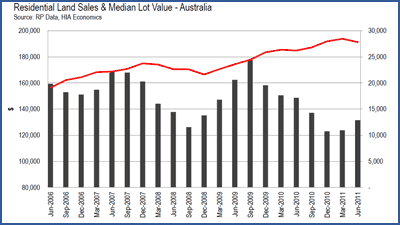New home building recovery at least six months off: HIA/RP Data
While an 18% increase in land sales in the June quarter is an encouraging sign, there will be no turnaround in the new home building sector until the March 2012 quarter at the earliest, according to Housing Industry Association and RP Data.
Despite the significant increase in land sales over the June quarter volumes are still 25% lower than in the June quarter last year and 51% lower than their June 2004 quarter peak, according to the HIA-RP Data Residential Land Report.
The release of the report coincides with quarterly ABS building activity data which shows the value of new residential building work done fell 5.3% to $9.53 billion over the June quarter on a seasonally adjusted basis.
“The profile for residential land sales remains weak, indicating that the earliest we can expect a turnaround in new housing starts is the March 2012 quarter,” says HIA chief economist Harley Dale.
“It is encouraging that land sales have stopped falling, but there is a long road ahead to ensure a sustainable recovery in new home building to levels commensurate with the housing requirements of Australia’s population,” he adds.

RP Data national research director Tim Lawless agrees that the improvement in land sales over the June quarter is an encouraging sign.
“Land sales provide a solid leading indicator for future dwelling commencements. A further improvement in land sales over the September and December quarters will be warmly welcomed by the development and home building sectors which have felt the full brunt of the housing downturn,” he says.
According to Lawless, the Australian vacant land market hit rock-bottom during the December quarter last year with the following March quarter not much better.
“The fact that land sales showed a marked improvement over the June quarter, a time when the RBA was still hinting at interest rates hikes, suggests land markets around the country are likely to continue showing an improvement in transaction volumes over the remainder of 2011,” he says.
Dale says the over the last decade in particular the cost of serviceable land has escalated at a rate far in excess of general inflation and building construction costs, “driven by a lack of appropriate land release and excessive, government-imposed costs”.
“Independent research finds that over 40% of the cost of a house and land package can be attributed to taxation and much of that burden falls within the serviceable land component. Policy reform to reduce the excessive taxation levied on new housing is vital to ensuring Australia’s poor record on housing affordability is sustainably turned around.”
While land sales picked up over the June quarter, median land prices fell marginally over this period, though prices are still higher than a year ago, the report found.
The weighted median land value in Australia fell by 1.3% in the June 2011 quarter to be 3.5% higher than the comparable quarter in 2010.
The median value for capital cities was effectively flat in the June 2011 quarter at $214,656, 5% higher than a year earlier.
The median value for regional Australia fell by 3.7% in the June 2011 quarter to $155,784, to be up by just 0.5% on the June 2010 quarter.